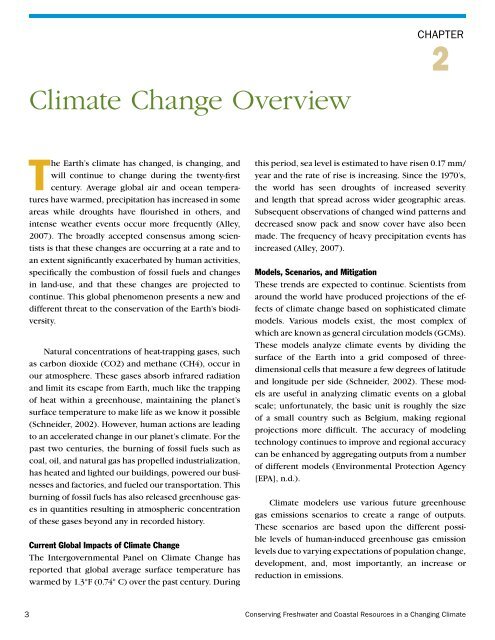Conserving Freshwater and Coastal Resources in a Changing Climate
Conserving Freshwater and Coastal Resources in a Changing Climate
Conserving Freshwater and Coastal Resources in a Changing Climate
Create successful ePaper yourself
Turn your PDF publications into a flip-book with our unique Google optimized e-Paper software.
<strong>Climate</strong> Change Overview<br />
CHAPTER<br />
2<br />
The Earth’s climate has changed, is chang<strong>in</strong>g, <strong>and</strong><br />
will cont<strong>in</strong>ue to change dur<strong>in</strong>g the twenty-first<br />
century. Average global air <strong>and</strong> ocean temperatures<br />
have warmed, precipitation has <strong>in</strong>creased <strong>in</strong> some<br />
areas while droughts have flourished <strong>in</strong> others, <strong>and</strong><br />
<strong>in</strong>tense weather events occur more frequently (Alley,<br />
2007). The broadly accepted consensus among scientists<br />
is that these changes are occurr<strong>in</strong>g at a rate <strong>and</strong> to<br />
an extent significantly exacerbated by human activities,<br />
specifically the combustion of fossil fuels <strong>and</strong> changes<br />
<strong>in</strong> l<strong>and</strong>-use, <strong>and</strong> that these changes are projected to<br />
cont<strong>in</strong>ue. This global phenomenon presents a new <strong>and</strong><br />
different threat to the conservation of the Earth’s biodiversity.<br />
Natural concentrations of heat-trapp<strong>in</strong>g gases, such<br />
as carbon dioxide (CO2) <strong>and</strong> methane (CH4), occur <strong>in</strong><br />
our atmosphere. These gases absorb <strong>in</strong>frared radiation<br />
<strong>and</strong> limit its escape from Earth, much like the trapp<strong>in</strong>g<br />
of heat with<strong>in</strong> a greenhouse, ma<strong>in</strong>ta<strong>in</strong><strong>in</strong>g the planet’s<br />
surface temperature to make life as we know it possible<br />
(Schneider, 2002). However, human actions are lead<strong>in</strong>g<br />
to an accelerated change <strong>in</strong> our planet’s climate. For the<br />
past two centuries, the burn<strong>in</strong>g of fossil fuels such as<br />
coal, oil, <strong>and</strong> natural gas has propelled <strong>in</strong>dustrialization,<br />
has heated <strong>and</strong> lighted our build<strong>in</strong>gs, powered our bus<strong>in</strong>esses<br />
<strong>and</strong> factories, <strong>and</strong> fueled our transportation. This<br />
burn<strong>in</strong>g of fossil fuels has also released greenhouse gases<br />
<strong>in</strong> quantities result<strong>in</strong>g <strong>in</strong> atmospheric concentration<br />
of these gases beyond any <strong>in</strong> recorded history.<br />
Current Global Impacts of <strong>Climate</strong> Change<br />
The Intergovernmental Panel on <strong>Climate</strong> Change has<br />
reported that global average surface temperature has<br />
warmed by 1.3°F (0.74° C) over the past century. Dur<strong>in</strong>g<br />
this period, sea level is estimated to have risen 0.17 mm/<br />
year <strong>and</strong> the rate of rise is <strong>in</strong>creas<strong>in</strong>g. S<strong>in</strong>ce the 1970’s,<br />
the world has seen droughts of <strong>in</strong>creased severity<br />
<strong>and</strong> length that spread across wider geographic areas.<br />
Subsequent observations of changed w<strong>in</strong>d patterns <strong>and</strong><br />
decreased snow pack <strong>and</strong> snow cover have also been<br />
made. The frequency of heavy precipitation events has<br />
<strong>in</strong>creased (Alley, 2007).<br />
Models, Scenarios, <strong>and</strong> Mitigation<br />
These trends are expected to cont<strong>in</strong>ue. Scientists from<br />
around the world have produced projections of the effects<br />
of climate change based on sophisticated climate<br />
models. Various models exist, the most complex of<br />
which are known as general circulation models (GCMs).<br />
These models analyze climate events by divid<strong>in</strong>g the<br />
surface of the Earth <strong>in</strong>to a grid composed of threedimensional<br />
cells that measure a few degrees of latitude<br />
<strong>and</strong> longitude per side (Schneider, 2002). These models<br />
are useful <strong>in</strong> analyz<strong>in</strong>g climatic events on a global<br />
scale; unfortunately, the basic unit is roughly the size<br />
of a small country such as Belgium, mak<strong>in</strong>g regional<br />
projections more difficult. The accuracy of model<strong>in</strong>g<br />
technology cont<strong>in</strong>ues to improve <strong>and</strong> regional accuracy<br />
can be enhanced by aggregat<strong>in</strong>g outputs from a number<br />
of different models (Environmental Protection Agency<br />
[EPA], n.d.).<br />
<strong>Climate</strong> modelers use various future greenhouse<br />
gas emissions scenarios to create a range of outputs.<br />
These scenarios are based upon the different possible<br />
levels of human-<strong>in</strong>duced greenhouse gas emission<br />
levels due to vary<strong>in</strong>g expectations of population change,<br />
development, <strong>and</strong>, most importantly, an <strong>in</strong>crease or<br />
reduction <strong>in</strong> emissions.<br />
3<br />
<strong>Conserv<strong>in</strong>g</strong> <strong>Freshwater</strong> <strong>and</strong> <strong>Coastal</strong> <strong>Resources</strong> <strong>in</strong> a Chang<strong>in</strong>g <strong>Climate</strong>

















